Use bag-to-the-wall technique to suture IOL
In patients with Marfan’s syndrome, this method is easy, simple to execute and gives reproducible results.
The dislocated lens in patients with Marfan’s syndrome and other causes of ectopia lentis presents a challenge for the cataract surgeon to overcome.
Here is a case in which the lens is subluxated by nearly 50% toward the 12 o’clock position. After making two side ports at 2 o’clock and 10 o’clock, we make a 2.5-mm clear corneal tunnel with a diamond knife at 11 o’clock.
It is essential to have a small, intact capsulorrhexis.
We start the tear with a small, sharp, bent 26-gauge needle so that we do not stress the weak zonules. Then we use small, sharp forceps to gradually complete the 3- to 4-mm capsulorrhexis. As the capsule is lax, this procedure might take a little time. Aim for a small rhexis, as the tendency is for the tear to extend.
Iris hooks
In order to fixate the capsule, we construct two more side ports at 7 o’clock and 4 o’clock, through which we have to introduce two iris hooks. These iris hooks are inserted in such a way as to hook the rhexis margin. A similar procedure is repeated on the other side. These hooks centralize the lens and for the duration of surgery provide efficient counter-traction. As the hooks are tightened, the lens and the capsular bag move toward the center of the eye. The anterior rhexis must be intact. This maneuver demonstrates how strong the curvilinear tear of the rhexis can be.
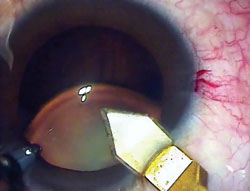 After making two side ports at 2 o’clock and 10 o’clock, a 2.5-mm clear corneal tunnel is made at 11 o’clock. |
 Iris hooks are inserted at 7 o’clock and 4 o’clock to hook the rhexis margin and centralize the lens. |
 Cataract is broken with chop technique. |
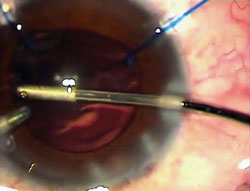 Bimanual irrigation and aspiration strips away remaining cortex using 200 mm Hg to 300 mm Hg of vacuum. |
 Capsular tension ring is injected through corneal tunnel, restoring the shape of the capsular bag. |
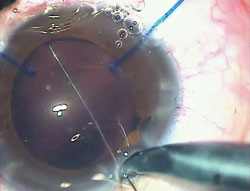 Straight needle with the 10-0 Prolene suture is introduced into the anterior chamber. |
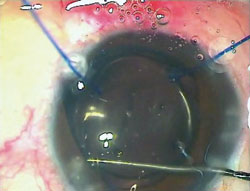 The lens is injected using standard technique and rotated into capsular bag. |
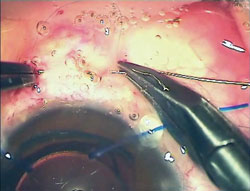 Needle is introduced into anterior chamber through corneal tunnel and exits through the fornix of the capsular bag at 6 o’clock. |
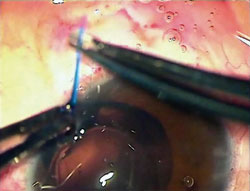 Suture is pulled through as leading haptic pushes the capsular bag against the eye wall. Needle passes through the sclera in a zigzag pattern. Images: Mehta CK |
After hydrodissection, which prolapses the nucleus upward, we can break the cataract into pieces with a chop technique, and minimal torsional phaco power is then used to emulsify the pieces. Next, we use bimanual irrigation and aspiration to strip away the remaining cortex, which is performed with just 200 mm Hg to 300 mm Hg of vacuum, as we do not want to pull on the bag.
The next step is to inject a capsular tension ring through the corneal tunnel in such a way as to support the bag throughout the inferior lax region. The capsular tension ring restores the shape of the capsular bag but will not reposition it in the center of the eye. The hooks are used for that.
A straight needle of a 10-0 Prolene suture is passed through the barrel of the cartridge of the injector until it exits through the other end. The end of the suture is tied to the midpoint of the leading haptic of this three-piece acrylic lens. Make sure it is tied snugly, as that is essential to the success of the procedure.
Inserting the cartridge
Once the lens is settled in the cartridge, insert it into the injector and pull the needle out. The needle is now introduced into the anterior chamber through the corneal tunnel and exits the eye through the sclera after passing through the fornix of the capsular bag at 6 o’clock. The lens is now injected into the bag using a standard injection technique and then rotated into the capsular bag. The suture is pulled so that the leading haptic snugly pushes the capsular bag against the eye wall, and the needle is then passed forward and back through the sclera in a zigzag pattern.
The hooks are released. The suture is pulled so that the leading haptic of the lens pulls the capsular bag toward the eye wall. Once suture tension has been adjusted, the needle is passed back through half-thickness of sclera the other way. This effectively locks the suture in place and centralizes the lens. The knot is then buried in a nick in the sclera, obviating the need for time-consuming scleral flap creation. This is an easy technique that is simple to execute and gives reproducible results.

- Cyres K. Mehta, MS, FASCRS, director of the Mehta International Eye Institute & Colaba Eye Hospital, can be reached at Sea Side, 147, Shahid Bhagat Singh Road, Colaba, Mumbai – 400005, India; e-mail: cyresmehta@yahoo.com.
